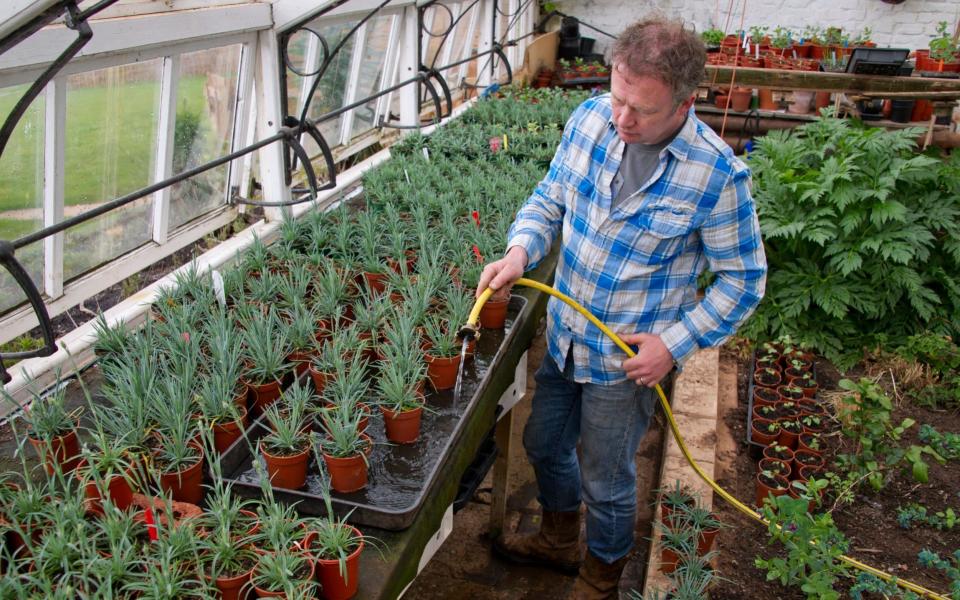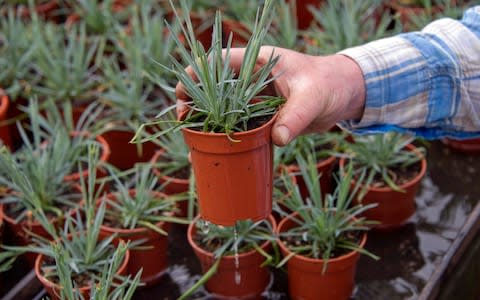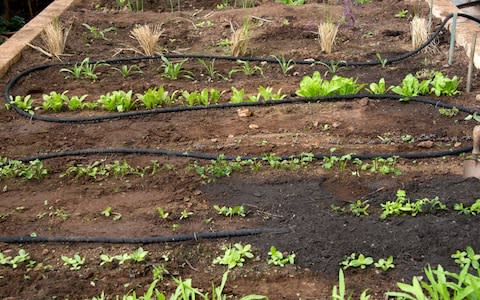Thirsty plants? Top tips for watering your garden in hot weather

Here we are again… gardens have a thirsty look in their eye.
Many lawns – especially those on sandy soils – have already turned to straw. So, watering is back on the agenda.
In theory we are never more than 18 months of very dry weather away from a drought. But the topsy-turvy British weather is, above all, unpredictable so by the time you read this we may well be in for months of torrential rain.
However, although a drought may be a long way off, gardeners have by now got the message to avoid wasting water by splashing it about ineffectively where it can do more harm than good.
On my Devon nursery, the irrigation system is called “me and my apprentice”, but even here in the wetter West we have a number of ways to conserve water and lighten the load.
Leaky hoses, dip tanks, water butts, mulching and good soil preparation all play their part. Whether you’re watering pots on an industrial scale or pottering about in a back garden, we’re all keen to save water and time where we can.
Greenhouse tactics

I do all my indoor watering in the early morning, but this is also the best time to water grey and felt-leaved plants like lavenders so their rot-prone foliage quickly dries in the sun.
Because of the risk of fungal infections, many professional herb growers don’t water foliage at all but use a “flood and drain” system.
Basically, the whole greenhouse floor is a giant concrete bath that is filled halfway up the sides of the pots. Then the plug is pulled and the water drains away.
Based on the same principle, I use a large plastic water trough to drench young plants that are easily washed out of their pots if watered with a hose.
A water bath doesn’t just rehydrate dry compost: as pots are lifted out of the drink, air — crucial for healthy rooting – is drawn in through the surface of the compost, making for faster growth rates.

Allotment and veg plot
Water butts are big on a nursery – forget about taking one watering can-full at a time.
An electric “lift pump” is similar to a pond pump used for a fountain, but has the oomph to push water up and out of a water butt (or well) and comes with a ballcock type “float switch” that automatically turns off the pump when the butt is pumped dry. To use, just connect a hose to the pump and lower it to the bottom of the butt or tank. They cost between £60 and £150 (drapertools.com).
The siphon method is cheaper and is a great trick I’ve used on my allotment to get water from the distant communal trough.

It relies on gravity and air pressure: as long as the end of the pipe is lower than the surface of the water it will work over tens, or even hundreds, of metres distance.
To create, put one end of a hosepipe under a brick in the bottom of a water tank and, working your way along from the submerged end, slowly sink the rest of the hose so all the air is replaced with water.
Put a thumb over the free end of the hose to prevent air from getting in while you take it to where you need the water, then lower the hose to the ground. Remove your thumb and water will flow — slowly at first but gradually increasing.
For plots without a tap, Jerry cans are a good option (I buy mine from Army surplus – £15 for a 20 litre can), though easier on the arms is the Victorian wheeled bowser.
This is basically a butt on wheels, with stout handles at the back so you can push it to parts of the garden that hoses cannot reach.
They are shaped like a huge milk jug and are designed to tip, but they come into their own for fast feeding. Fill with water, stir in the liquid feed and trolley off around the garden, scooping a can whenever you see hungry plants.
It’s easiest to buy new – although modern plastic versions have all the appeal of a wheelie bin (tanks-direct.co.uk). You can also hire one (water-direct.co.uk). Expect to pay around £350 for a Victorian original on eBay.
Dry borders
I raise hundreds of perennials, planted in bar code-like stripes across what was once an old paddock.
Leaky hose irrigation is the most efficient way to keep young plants from going thirsty.

Also known as porous pipe, it attaches to the tap via an ordinary hose and, when turned on, it weeps along its length gradually soaking a strip of soil 2ft (60cm) wide. In a border, snake pipe through plants 2ft apart.
How long you leave the water running depends on your soil — in sandy ground water doesn’t spread sideways as far as on clay but tends to percolate straight down.
So the first time you turn on the tap, run the hose for an hour and then trowel down to a depth of 6in (15cm) to check if the soil below the surface is moist. If not, leave water running until it is and make a note of how long it took. It’s better to water infrequently but deeply, rather than little and often, as this encourages roots to chase the moisture down.
Leaky hose is exempt from any hose pipe ban, but boy is it ugly, so I pin it into the soil with home-made wire ties and disguise it with a mulch.
For larger areas (although not when water restrictions are in force), sprinklers are best. If used in the evening or early morning, not only will the spray look beautiful backlit by the sun, less water will be lost to evaporation.
If using overhead sprinklers, a rain gauge is useful to measure what reaches the ground. I have a few on the nursery to tell me how much to top up after showers.
Patio and balcony

With containers and high-flung window-boxes and baskets, automatic systems (hozelock.com) are worth considering.
Developed from the hidden irrigation systems designed to water permanent displays at botanic gardens and shopping malls, fitting them is like assembling Ikea furniture – easy when you know how.
Kits come with a “main” tough hose pipe that connects to the tap plus a spaghetti of malleable thinner pipe.
This gets cut into shorter lengths and plugs into the main pipe, diverting water to where it’s needed.
The end result looks like a supersized millipede with a thick body and as many legs as you have pots to water.
What makes these systems seem complicated is the array of attachments and nozzles to choose from that connect to the thinner hoses, including sprays, drippers, sprinklers and squirters.
The drip attachments deliver just five litres of water an hour.
The best kits come with adjustable drippers so you can slow the flow to satisfy both drought-loving and thirsty plants on the same run of pipe.
Drippers deliver water to the crowns of plants, but these won’t satisfy trees, shrubs or rows of veg. For this you need to choose from the sprinklers, jets and spray nozzles that squirt out 10 times the volume of water.

